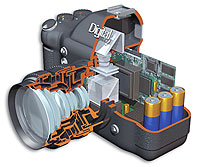When we talk of Digital Cameras, there is that word that has synonymously been associated with modernity; e.g. “Digital Radio”, “Digital TV”, “Digital Music”, “Digital Driving Permits”, “Digital ID Cards” Digital this and digital that.


When we talk of Digital Cameras, there is that word that has synonymously been associated with modernity; e.g. "Digital Radio”, "Digital TV”, "Digital Music”, "Digital Driving Permits”, "Digital ID Cards” Digital this and digital that.
This is a phenomenon that has come with advancement in technology; but what is this animal called "Digital” that denominates much of our modern life?
In order to conceive the digital camera, let us briefly address ourselves to the phenomenon at the foundation of its very existence.
Under the digital revolution, things are done and conceptualised in terms of two numbers, viz "zeros” and "ones”.
What is the logic behind this? The zeros represent the absence, nothingness or negativity and the ones represent the presence or positivity.
Precisely, Digitalism describes electronic technology that generates, stores, and processes data in terms of two states: positive and non-positive. Positive is expressed or represented by the number 1 and non-positive by the number 0.
Thus, data transmitted or stored with digital technology is expressed as a string of 0’s and 1’s.
Each of these state digits is referred to as a bit (and a string of bits that a computer can address individually as a group is a byte), the bytes may be accumulated into kilobytes, megabytes, gigabytes, nanobytes e.tc.
Before the digital technology, lectronic functionalities were limited to analog technology, which conveys data as electronic signals of varying frequency or amplitude that are added to carrier waves of a given frequency. Radio, TV broadcast and telephone phone transmissions had to adopt the analog technology.
Not anymore, nearly everything is going digital, thanks to the invention of the computer.
Digital cameras produce instant photos that you can print or share online. Digital cameras focus light onto a semiconductor to create a digital image.
This is directly in contrast with the analog cameras that required a piece of photosensitive device known as the film in order for them to be able to capture photographs.
In turn, the film had to run from start to end (analog), they then required processing (developing) with aid of chemicals so that the images could be fixed and to "kill” further sensitivity to light so that the film does not write over the "saved” images. Once used, the film was spent and could not be re-used again.
The pictures taken on the film are in negative form, i.e. the images are captured in a reverse form of what they are so that, when they are printed on paper, they are again reversed to become positive.
As opposed to film images, the digital camera captures the pictures there and then, stores them on the Camera’s memory or other secondary forms of digital storage.
In order for someone to send or publish online any of the conventional photographs, one has to convert them into digital form by either scanning them or re-photographing them with a digital camera or otherwise.
The new photographic digital approach has been enormously successful. Since films are still in use and can sometimes provide very good picture quality, digital cameras have not completely replaced conventional cameras.
But, as the digital imaging technology keeps improving, the digital cameras are becoming more and more popular.
Basically, if you wanted to take a picture and e-mail it to a friend, you would need the image to be represented in the language that computers recognize, the bits and bytes.
Simply put, a digital image is just a long string of 1s and 0s that represent all the tiny coloured dots in a picture. These dots are what we call "pixels”, hese collectively make up an image.


